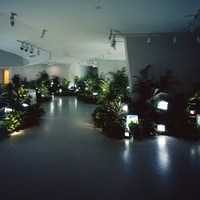TV Garden
Item
-
Title
-
TV Garden
-
Description
-
No artist had a greater influence in revealing the artistic potential lurking behind television’s flickering facade than Nam June Paik. Commonly hailed as the father of video art, Paik reshaped perceptions of the electronic image through a prodigious output of manipulated TV sets, live performances, global television broadcasts, single-channel videos, and video installations. His career took him from Asia through Europe to the United States, and Paik’s complex media-based art grew out of his early interests in electronics, as well as his foundations in performance and music. Arriving in New York in the mid-1960s, he joined a new generation of artists that was altering the ways in which one interacts with the moving image. Paik became a prominent member of the Fluxus movement, whose principles included the transformation of quotidian actions—like the buttoning and unbuttoning of a coat, as seen in his video Button Happening (ca. 1965)—into art. Quickly emerging at the forefront of this movement, Paik also sought to involve the viewer as an active participant in his performances and installations, and he often introduced elements of surprise and the unfamiliar.
TV Garden, one of his seminal installations, illustrates Paik’s profound grasp of technology’s capacity for composition and the new aesthetic discourse that he helped to create. To enter the piece is to experience an uncanny fusion of the natural and the scientific, as hidden amid an undergrowth of live plants are video monitors of various sizes. All are playing the artist’s 1973 collaboration with John J. Godfrey, Global Groove, which montages performers from around the world into a gyrating visual mix, and the videotape’s sound track serves as musical and spoken counterpoint to the monitors’ flickers of light. TV Garden set a new standard for immersive, site-specific video installations. Restaged for the artist’s exhibition at the Guggenheim Museum in 2000, its influence can be seen decades later in ambient, room-sized installations by such artists as Gary Hill and Bill Viola.
For Paik, the artist should not be limited in seeking new forms of creative expression, but rather the potential for innovation must be continually reimagined. Just as Paik reconceived broadcast television in the 1960s and 1970s in order to “turn it inside out” and deliver a fresh take on this means of communication, Paik turned to laser technology as a novel type of sculptural and installation art at the beginning of the 21st century. He continued to dismantle customary ways of seeing and expand the parameters of art making throughout his career.
-
Date
-
1974
-
Extent
-
Color video, with sound, 29 min., with a minimum of 30 television sets
-
Identifier
-
NJP04
 TV Garden
TV Garden